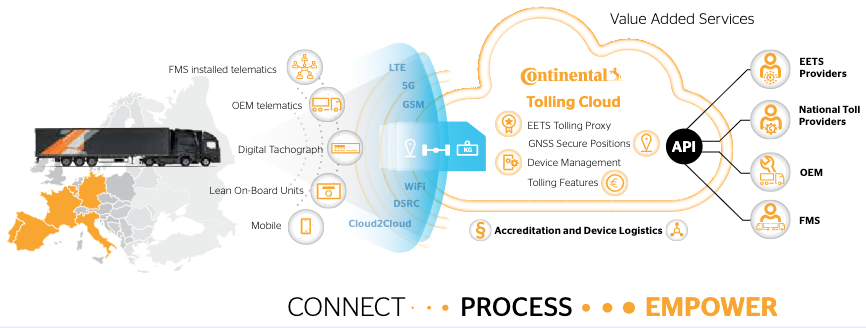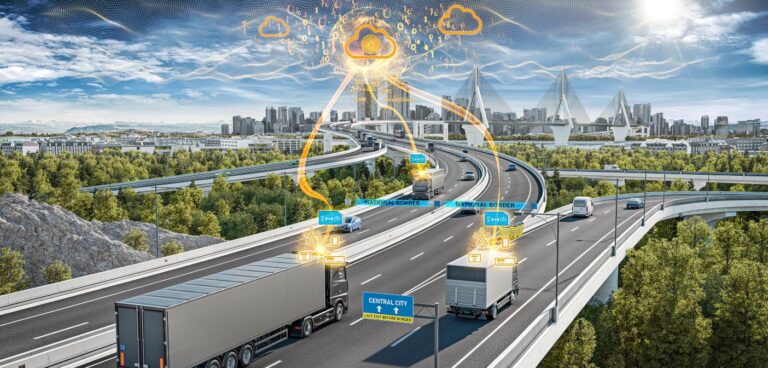On-board units serve to communicate with toll barriers and roadside toll stations. Since the EETS directive, a single OBU can do this across many European countries. Dr Andreas Müller, director of telematics and fleet management for Continental’s commercial vehicle fleet services business segment, explains the rationale and benefits of saying farewell to this piece of hardware and hello to distributing its function across existing truck infrastructure.
On-board units (OBUs) have simplified tolling across the European Union (EU). That’s the good news. However, new technologies and a new E/E architecture are rapidly changing the situation. We are witnessing the dawning age of software in vehicles of all types. For fleet operators and European Electronic Toll Service providers (EETS) this opens up the opportunity to distribute the OBU’s functional elements to existing vehicle hardware. But hang on, why would we do that? Why change a winning team?
Well, first of all, it is not always winning. While the installation is easy, OBUs bring a few potential quality issues. Occasionally they are incorrectly installed, or the power supply is unreliable because lighter sockets can sometimes produce an intermittent contact. However, if the OBU does not work properly, the truck user might become a toll offender who will be prosecuted.
Also, current OBUs have no data link to the vehicle. The distinct OBU identity is solely linked to the vehicle identity within the IT system of the EETS provider. If an OBU is installed in another vehicle by mistake, there will be a mismatch between OBU identity and vehicle identity.
Further, it does not help that OBUs work with two different technologies – dedicated short range communication (DSRC with 5.8GHz as specified by CEN TC278) and the global navigation satellite service (GNSS), neither of which is truly standardised across Europe for the purpose of tolling.
However, the biggest pain point is this: getting an accreditation for an OBU requires lengthy conformity testing, which includes many miles of real-world test driving. This process can take as long as 10 months for one country alone. Every time the OBU hardware is changed, the process needs to be re-started. As a result, OBU hardware is used “till kingdom come” – the opposite of faster innovation cycles.
Moving on from OBU to OBE
As the problem is the isolated hardware, the logical conclusion is to replace it with a distributed, hardware-independent and updateable on-board equipment (OBE) solution. GNSS sensor data, for instance, can be delivered by the navigation system or the smart tachograph. The tachograph also contains a DSRC modem, which can in future be used for tolling as well.
The user interface can be provided via the existing head unit, which offers the benefit of providing a consistent interaction concept. For the data exchange to the proxy via mobile internet there is a whole choice of solutions. Updateable software controls the complete toll collection by utilising individual OBE system components and ensuring that only correct and complete data is collected and transmitted to the proxy.
In addition, software prevents manipulations and unauthorised access. As the E/E architecture is dramatically changing towards a server-based approach and software-defined vehicles, this hardware-independent OBE solution is future safe.
A distributed OBE avoids problems of the “incorrect installation”, “loose electrical connection” or “mismatch” type. Utilising existing vehicle hardware saves the invest in the OBU as a dedicated device. Making the digital smart tachograph one of the main components of a distributed OBE solution can greatly contribute to the security level and manipulation safety. It would also improve the tolling data quality.

Add this: the European Commission’s Mobility Package makes it necessary to retrofit trucks used by fleet owners for international transport with new smart tachographs that document compliance with the new rules.
The deadline for this is the year 2025. Does it really make sense to fit applicable commercial vehicles with a smart tachograph (2nd generation) without adding the benefit of a distributed OBE? Making this happen requires EU-wide harmonised OBE conformity testing based on interface standardisation. OBE is a system distributed over the vehicle comprising interoperability constituents. The path into the future is defining harmonised test standards for all interoperability constituents. As an alternative to EU-wide standardising a test suite, an industry standard for interoperability testing could be a viable strategy. Successful examples can be found in the Bluetooth-SIG. However, whatever the approach, it will make it possible to reap the economic benefits of a distributed OBE instead of praying that the good old hardware will last yet another year.
To learn more on what will likely happen after the end of the OBU age in tolling and about the six major benefits Continental has identified for an OBE future, download this Continental Whitepaper now: www.continental-mobility-services.com/en-en/future-of-cv-tolling





